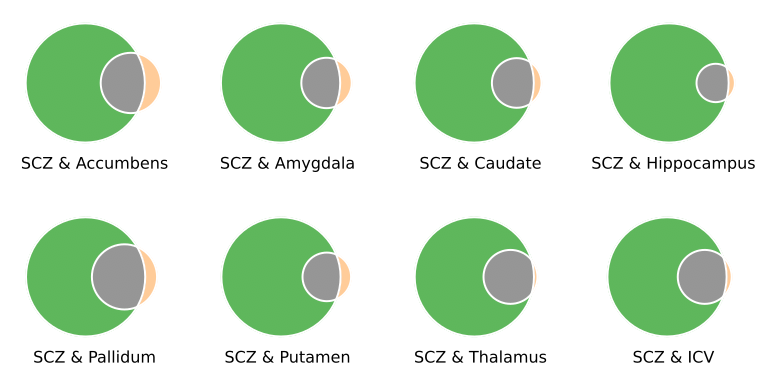Schizophrenia is a severe mental disorder that can involve symptoms like hallucinations, delusions and cognitive deficits. This disorder affects around 1% of the worldwide population, and typically presents in the early 20s. Large brain imaging studies show that patients with schizophrenia have differences in their brain compared to people without this disorder [1, 2]. Can genetics explain these brain differences?
The role of genetics in the development of schizophrenia and the brain
Schizophrenia is heritable, and during the last years hundreds of genetic variants have been identified for the disorder [3]. Genetic variants are DNA sequence differences among individuals, and a genetic variant associated with schizophrenia indicates that this variant may increase or decrease a person's risk of developing schizophrenia.
The brain difference found in patients with schizophrenia, including a smaller and thinner cortex and altered subcortical volumes, are also heritable. These brain structures are involved in parts of the brain associated with learning and memory. If we imagine our brain is avocado with an outer skin, flesh, and an inner stone, cerebral cortex is the skin, subcortical structure is the stone, and the fresh represent the white matter. Studies have connected genetic information to the above measures of brain structure, i.e., cortical thickness and area, and subcortical volumes [5–7].
As both schizophrenia and brain structure are heritable, one important question is whether the same genetic variants are involved. The overall aim of my research is to understand the relationship between schizophrenia and brain structure from a genetic perspective. This could not only improve our understanding of the disorder and the brain in general, but also take us one step further towards the relationship between schizophrenia and the brain.
Is there a genetic link between the risk of schizophrenia and the brain?
We have conducted two studies to determine whether schizophrenia shares genetic variants with brain structural measures, including cortical thickness and area, and subcortical volumes[8, 9]. Our findings show that the majority of associated variants for a brain measure also contribute to schizophrenia, giving us evidence for a genetic link between schizophrenia and the brain (see illustration below).
The shared genetic variants we identified were linked to genes involved in neurodevelopmental processes, happening even before birth. As schizophrenia has been postulated as the end result of abnormal brain development that occurs long before the onset of clinical symptoms, we investigated whether shared genes are connected to brain development in children aged 9-10 years. Two genes, CRHR1 and ARL17A, have been proposed to be linked to the volume of thalamus. These findings may help explain the brain changes seen in patients with schizophrenia.

What’s next?
Going forward, it is still unclear if shared genetic variations impact schizophrenia and the brain independently or if the brain has a role in how schizophrenia is affected by genes. With the emerging advanced methods in statistics and brain imaging, we will continue our research in this field, which we believe will eventually help us understand schizophrenia, and contribute to better prevention and treatment of the disorder in the future.
References
-
Trubetskoy, V. et al. Mapping genomic loci implicates genes and synaptic biology in schizophrenia. Nature 604, 502–508 (2022).
-
Hibar, D. P. et al. Novel genetic loci associated with hippocampal volume. Nat Commun 8, 13624 (2017).
-
Grasby, K. L. et al. The genetic architecture of the human cerebral cortex. Science 367, (2020).
-
van Erp, T. G. M. et al. Cortical Brain Abnormalities in 4474 Individuals With Schizophrenia and 5098 Control Subjects via the Enhancing Neuro Imaging Genetics Through Meta Analysis (ENIGMA) Consortium. Biol. Psychiatry 84, 644–654 (2018).
-
van Erp, T. G. M. et al. Subcortical brain volume abnormalities in 2028 individuals with schizophrenia and 2540 healthy controls via the ENIGMA consortium. Molecular Psychiatry 21, 547–553 (2016).
-
Cheng, W. et al. Genetic Association Between Schizophrenia and Cortical Brain Surface Area and Thickness. JAMA Psychiatry (2021).
-
Cheng, W. et al. Shared genetic architecture between schizophrenia and subcortical brain volumes implicates early neurodevelopmental processes and brain development in childhood. Mol Psychiatry (2022).
